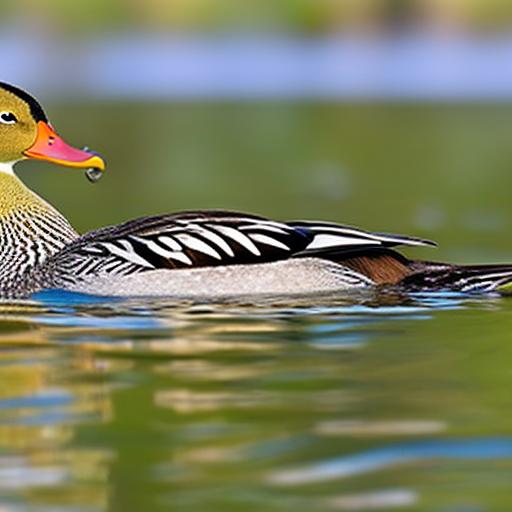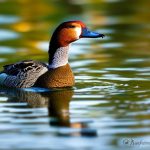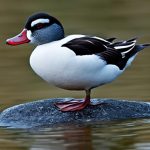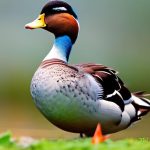Big duck breeds are a popular choice among poultry enthusiasts for their impressive size and unique characteristics. These breeds are known for their large bodies, which can make them stand out in a flock of ducks. They are also known for their friendly and social nature, making them a favorite among those who enjoy interacting with their poultry.
Big duck breeds come in a variety of sizes and colors, each with its own distinct characteristics. Some of the most popular big duck breeds include the Pekin, Muscovy, Rouen, Cayuga, and Aylesbury. These breeds are not only prized for their size, but also for their meat and egg production capabilities.
Key Takeaways
- Big duck breeds are popular among poultry enthusiasts due to their size and unique characteristics.
- The top 5 largest duck breeds in the world are the Muscovy, Pekin, Rouen, Aylesbury, and Cayuga.
- Understanding the characteristics and behaviors of big ducks is important for proper care and management.
- The history and evolution of big duck breeds can be traced back to ancient times and have been selectively bred for various purposes.
- When selecting the right breed, factors such as temperament, egg production, and meat quality should be considered.
The Top 5 Largest Duck Breeds in the World
1. Pekin Duck: The Pekin duck is one of the largest domesticated duck breeds in the world. They can weigh up to 10 pounds and have a white plumage with orange bills and feet. Pekin ducks are known for their calm and friendly temperament, making them a popular choice among backyard poultry enthusiasts. They are also excellent layers, producing around 200-300 eggs per year.
2. Muscovy Duck: The Muscovy duck is another large breed that can weigh up to 15 pounds. They have a unique appearance with a red face and warty growths on their face and bill. Muscovy ducks are known for their ability to fly, unlike many other domesticated duck breeds. They are also excellent foragers and can help control pests in the garden.
3. Rouen Duck: The Rouen duck is a breed that originated in France and is known for its large size and beautiful plumage. They can weigh up to 10 pounds and have a striking color pattern with iridescent green heads and gray bodies. Rouen ducks are calm and docile, making them a popular choice for backyard flocks. They are also good layers, producing around 100-150 eggs per year.
4. Cayuga Duck: The Cayuga duck is a breed that originated in the United States and is known for its unique coloration. They have black feathers that can have a greenish sheen in the sunlight. Cayuga ducks are medium-sized, weighing around 6-8 pounds. They are known for their calm and friendly temperament, making them a popular choice for backyard flocks. They are also good layers, producing around 100-150 eggs per year.
5. Aylesbury Duck: The Aylesbury duck is a breed that originated in England and is known for its large size and white plumage. They can weigh up to 10 pounds and have a distinctive pink bill and orange feet. Aylesbury ducks are calm and friendly, making them a popular choice for backyard flocks. They are also good layers, producing around 100-150 eggs per year.
Understanding the Characteristics and Behaviors of Big Ducks
Big ducks have unique characteristics and behaviors that set them apart from other duck breeds. One of their most notable characteristics is their swimming ability. Big ducks have large bodies and webbed feet, which make them excellent swimmers. They enjoy spending time in water and will often paddle around in ponds or pools.
Big ducks are also known for their social nature. They enjoy being part of a flock and will often form strong bonds with other ducks. They are friendly towards humans and can be easily trained to come when called or perform simple tricks.
When caring for big ducks, it is important to provide them with plenty of space to roam and access to water for swimming. They should also be provided with a balanced diet that includes a mix of grains, vegetables, and protein sources.
The History and Evolution of Big Duck Breeds
Big duck breeds have a long history that dates back centuries. The exact origins of these breeds are not always clear, but they are believed to have originated in different parts of the world.
The Pekin duck, for example, is believed to have originated in China and was brought to the United States in the 19th century. It quickly became popular for its large size and meat production capabilities.
The Muscovy duck is believed to have originated in South America and was domesticated by indigenous people thousands of years ago. It was later brought to Europe by explorers and eventually spread to other parts of the world.
The Rouen duck is believed to have originated in France and was bred for its large size and beautiful plumage. It was popularized in England during the 19th century and eventually made its way to the United States.
The Cayuga duck is believed to have originated in North America and was named after Cayuga Lake in New York. It was bred for its unique coloration and eventually became popular for its meat and egg production capabilities.
The Aylesbury duck is believed to have originated in England and was bred for its large size and white plumage. It was popularized in the 18th century and became known for its meat production capabilities.
Selecting the Right Breed: Factors to Consider
When selecting a big duck breed, there are several factors to consider. One of the most important factors is temperament. Some big duck breeds, such as the Pekin and Rouen, are known for their calm and friendly temperament, while others, such as the Muscovy, can be more independent.
Another factor to consider is egg production. If you are looking for a breed that will provide you with a steady supply of eggs, then breeds like the Pekin or Cayuga may be a good choice. These breeds are known for their good egg-laying capabilities.
Meat quality is another important factor to consider. If you are raising ducks for meat production, then breeds like the Pekin or Aylesbury may be a good choice. These breeds are known for their tender and flavorful meat.
Housing and Feeding Requirements for Big Ducks

Big ducks require adequate housing and feeding to thrive. They need a shelter that provides protection from the elements and predators. The shelter should be spacious enough to accommodate their large size and should have proper ventilation to prevent respiratory issues.
Big ducks also need access to water for swimming. This can be provided through a pond, pool, or even a large tub. It is important to regularly clean and change the water to prevent the spread of diseases.
In terms of feeding, big ducks require a balanced diet that includes a mix of grains, vegetables, and protein sources. Commercial duck feed can be supplemented with fresh fruits and vegetables, as well as insects and worms.
Breeding and Incubation Techniques for Big Duck Eggs
Breeding big ducks requires careful selection of breeding pairs. It is important to choose ducks that are healthy, have good conformation, and exhibit desirable traits. Breeding pairs should be introduced at the appropriate time and allowed to mate naturally.
Once the eggs are laid, they can be collected and incubated. Incubation requires a temperature-controlled environment with proper humidity levels. The eggs should be turned regularly to ensure even heat distribution.
After about 28 days, the eggs will hatch and the ducklings will emerge. They should be provided with a warm and safe environment to grow and develop.
Health Concerns and Common Diseases in Big Ducks
Big ducks are generally hardy birds, but they can still be susceptible to certain health concerns and diseases. Some common health concerns in big ducks include respiratory issues, parasites, and foot problems.
Respiratory issues can occur if the ducks are kept in damp or poorly ventilated conditions. It is important to provide them with a clean and dry environment to prevent respiratory issues.
Parasites, such as mites and lice, can also affect big ducks. Regular cleaning and inspection of the ducks can help prevent infestations.
Foot problems can occur if the ducks are kept on hard or rough surfaces for extended periods of time. Providing them with soft bedding or grassy areas can help prevent foot problems.
Regular veterinary check-ups and vaccinations can also help prevent and treat common diseases in big ducks.
Utilizing Big Ducks for Meat and Egg Production
Big ducks can be utilized for both meat and egg production. Their large size makes them ideal for meat production, as they provide a good amount of tender and flavorful meat.
For egg production, breeds like the Pekin and Cayuga are known for their good egg-laying capabilities. They can provide a steady supply of eggs throughout the year.
To maximize meat and egg production, it is important to provide the ducks with a balanced diet, proper housing, and regular veterinary care. It is also important to provide them with a stress-free environment to ensure optimal production.
The Future of Big Duck Breeds: Trends and Innovations in Poultry Farming
The future of big duck breeds looks promising, with trends and innovations in poultry farming that may impact these breeds. One trend is the increasing demand for locally sourced and ethically raised meat and eggs. Big duck breeds can meet this demand by providing high-quality meat and eggs that are raised in a humane and sustainable manner.
Another trend is the use of technology in poultry farming. Innovations such as automated feeding systems, climate-controlled housing, and genetic selection techniques can help improve the efficiency and productivity of big duck breeds.
Exciting developments to look forward to in the world of big duck breeds include the development of new breeds with improved traits, such as increased meat or egg production capabilities. There is also ongoing research into the health and welfare of big ducks, with a focus on preventing and treating common diseases.
Big duck breeds are a popular choice among poultry enthusiasts for their impressive size and unique characteristics. They come in a variety of sizes and colors, each with its own distinct characteristics. Understanding the characteristics and behaviors of big ducks is important for providing them with the best care.
The history and evolution of big duck breeds is fascinating, with each breed having its own origins and breeding history. When selecting a big duck breed, factors such as temperament, egg production, and meat quality should be considered.
Providing the right housing and feeding requirements for big ducks is essential for their health and well-being. Breeding and incubation techniques can help ensure successful reproduction, while proper healthcare can prevent and treat common diseases.
Big ducks can be utilized for meat and egg production, providing a sustainable source of high-quality food. The future of big duck breeds looks promising, with trends and innovations in poultry farming that can improve their productivity and welfare.
Overall, exploring the world of big duck breeds can be a rewarding experience for poultry enthusiasts. Whether you are interested in raising ducks for meat or eggs, or simply enjoy their unique characteristics, big duck breeds offer something for everyone.
If you’re interested in big duck breeds, you might also want to check out this helpful article on poultrywizard.com about where to put your chicken coop. Proper placement of your coop is essential for the health and well-being of your ducks, as it can affect their comfort, safety, and egg production. This article provides valuable insights and tips on finding the ideal location for your coop. So, if you’re looking to create a suitable environment for your big duck breeds, be sure to give it a read! (source)
FAQs
What are big duck breeds?
Big duck breeds are domesticated ducks that are larger in size compared to other duck breeds. They are usually raised for meat production, egg-laying, or as ornamental birds.
What are some examples of big duck breeds?
Some examples of big duck breeds include the Pekin duck, Muscovy duck, Rouen duck, Aylesbury duck, and the Cayuga duck.
What is the average size of big duck breeds?
The average weight of big duck breeds ranges from 4 to 10 pounds, with some breeds weighing up to 15 pounds. They can also grow up to 2 feet in length.
What is the lifespan of big duck breeds?
The lifespan of big duck breeds varies depending on the breed and their living conditions. On average, they can live up to 10 years or more if they are well-cared for.
What are big duck breeds used for?
Big duck breeds are primarily used for meat production and egg-laying. Some breeds are also kept as ornamental birds for their unique appearance and colorful plumage.
What is the temperament of big duck breeds?
The temperament of big duck breeds varies depending on the breed and their living conditions. Generally, they are docile and friendly birds that can be easily trained and handled. However, some breeds can be more aggressive than others, especially during breeding season.
Meet Walter, the feathered-friend fanatic of Florida! Nestled in the sunshine state, Walter struts through life with his feathered companions, clucking his way to happiness. With a coop that’s fancier than a five-star hotel, he’s the Don Juan of the chicken world. When he’s not teaching his hens to do the cha-cha, you’ll find him in a heated debate with his prized rooster, Sir Clucks-a-Lot. Walter’s poultry passion is no yolk; he’s the sunny-side-up guy you never knew you needed in your flock of friends!







